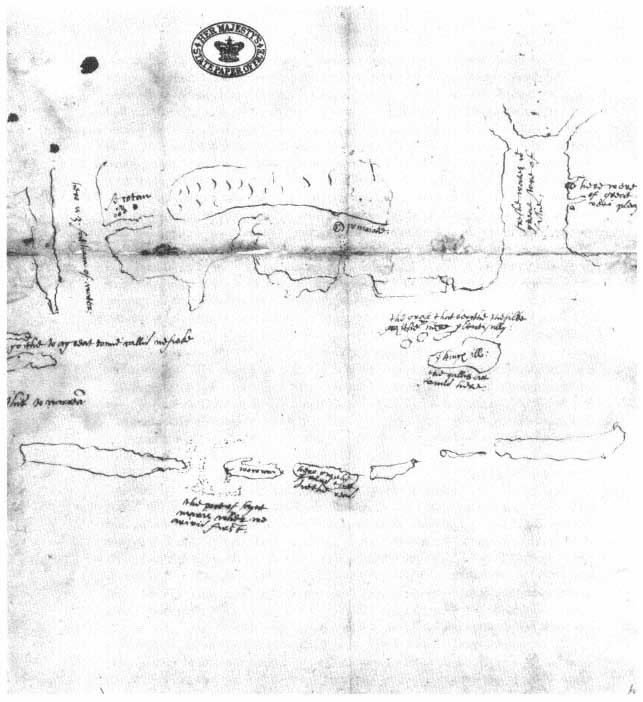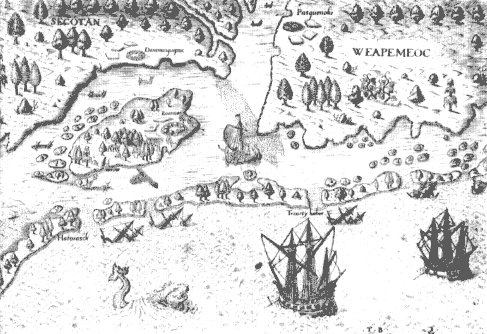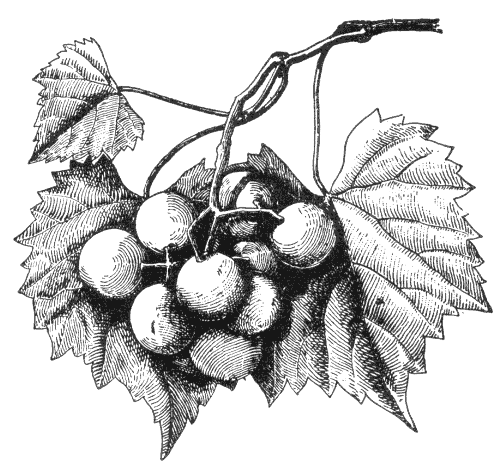Early Explorers and Native Grapes
All of the explorers and early settlers made note of the abundant and vigorous wild grape vines—they could hardly help doing so, since they were obviously and everywhere to be seen along the coast of eastern North America. Within two years of Columbus's discovery, for example, the Spaniards reported vines growing in the Caribbean islands. [9] The Pilgrims in New England found the species now called Vitis labrusca growing profusely in the woods around their settlements. [10] The labrusca, or northern fox grape, is the best looking of the natives, with large berries that may come in black, white, or red. It is the only native grape that exhibits this range of colors. Labrusca is still the best known of the native species because the ubiquitous Concord, the grape that most Americans take to be the standard of "grapeyness" in juice and jellies, is a pure example of it.
The name "fox grape" often given to labrusca yields the adjective foxy , a word unpleasant to the ears of eastern growers and winemakers as an unflattering description of the distinctive flavor of their labrusca grapes and wines, a flavor unique to eastern America and, once encountered, never forgotten. One of the dominant elements in that flavor, the chemists say, is the compound methyl anthranilate; [11] it can be synthesized artificially to produce the flavor of American grapeyness wher-
ever it may be wanted. But why this flavor (which, like all flavors, is largely aroma) should be called "foxy" has been, and remains, a puzzle (see Appendix 1).
Hundreds of miles to the south of the Pilgrim settlements, and even before the Pilgrims landed, the gentlemen of the Virginia Company at Jamestown encountered a number of native grape species, among them the very distinctive one called Vitis rotundifolia —round leaf grape—that grows on bottom lands, on river banks, and in swamps, often covering hundreds of square feet with a single vine. The rotundifolia grape, commonly called muscadine, differs sharply from other grapes; so different is it, in fact, that it is often distinguished as a class separate from "true grapes." The vine is low and spreading, and the large, tough-skinned, round fruit grows not in the usual tight bunches but in loose clusters containing only a few berries each: hence the variant name of bullet grape. The fruit is sweet, but like that of almost all natives, its juice usually needs to have sugar added to it in order to produce a sound wine. The fruit has also a strong, musky odor based on phenylethyl alcohol that carries over into its wine. [12] Scuppernong is the best-known variety of rotundifolia, and the name is sometimes loosely used to stand for the whole species.
Both Pilgrims in the north and Virginians in the south would have known the small-berried and harsh-tasting Vitis riparia —the riverbank grape—which is the most widely distributed of all native American grapes (difficulties in classification have produced some variant names for this species, of which Vitis vulpina is the most common). Riparia ranges from Canada to the Gulf, and west, with diminishing frequency, to the Great Salt Lake. As its name indicates, riparia chooses river banks or islands. As its range suggests, it has a tough and hardy character that allows it to survive under a great variety of conditions. It is currently, for example, being used as a basis for hybridizing wine grapes for the cold climates of Minnesota and Wisconsin. [13]
Another grape widespread throughout the eastern United States is Vitis aestivalis , the summer grape, the best adapted to the making of wine of all the North American natives, though not the most widely used. Unlike the rotundifolia and others, it has adequate sugar in its large clusters of small berries; and it is free of the powerful "foxy" odor of the labrusca. Aestivalis fills in the gaps left by riparia and labrusca, for unlike the former it avoids the streams, and, unlike the latter, it prefers the open uplands to the thick woods. Another grape common in the East, Vitis cordifolia , the winter grape, has a taste so harshly herbaceous that only under the most desperate necessity has it ever been used for wine.
As settlement moved beyond the eastern seaboard and made its way west, a new range of species and varieties was encountered, though none of such importance as those just named. The best known is Vitis rupestris , the sand grape, which favors gravelly banks and dry water courses and is distributed through the region around southern Missouri and Illinois down into Texas. Since it is not a tree climber, it has been very vulnerable to grazing stock and is now almost extinct in many areas.
There are many other species and subspecies that might be named among the

2
Sketch-map of Raleigh's Virginia (that is, the North Carolina coast), September 1585. The note at the far
right of the sketch reads: "Here were great store of great red grapis veri pleasant." Grapes were thus among
the first things to greet the English in the New World. (From D. B. Quinn, ed., The Roanoke Voyages,
1584—1590 [1955]; original in the Public Record Office, London)

3
"The arriual of the Englishemen in Virginia": drawing by John White, engraved by Theodor de Bry,
based on the sketch-map shown in Fig. 2. The drawing represents grapes under the word "Weapemeoc"
in a position corresponding to that indicated on the sketch-map. (Theodor de Bry, America , part
I [Frankfurt am Main, 1590]; Huntington Library)
native vines, but those already given include most of the varieties that formed the stock available to the early settlers and that have since had any significance in the development of hybrid vines.[14] Two things may be said generally about the natives by way of summarizing their importance both to the American industry and to the world of wine at large. First, except for the muscadine, they enter readily into combination with other species, so that by judicious hybridizing their defects have been diminished and their virtues enhanced in combination with one another and with Vitis vinifera . Such improvement through breeding began in the nineteenth century (though some very important accidental crosses had occurred earlier) and has been continued without intermission since: had it been begun earlier in a deliberate way, the whole face of winemaking in the United States might have been changed beyond recognition. Second, the native vines have, or some of them at any rate have, an inherited resistance to the major enemies of the vine in North America: the endemic fungus diseases that destroy leaves and fruit; and the plant louse called Phylloxera vastatrix , a scourge native to North America and introduced with catastrophic effect into Europe in the latter half of the nineteenth century. By

4
The characteristic native grape of the American South, Vitis rotundifolia . the muscadine.
often loosely referred to as "Scuppernong." Flourishing especially in the Carolinas, it was
probably the source of the first American wine and was the basis of Virginia Dare, once the
most popular wine in America. (From Liberty Hyde Bailey. Sketch of the Evolution of Our
Native Fruits [1898])
grafting V. vinifera to American roots, the winegrowers of Europe were able to save their industry at a time when it seemed likely that the ancient European civilization of the vine was about to become a thing of the past.
The summary just given is based on information laboriously accumulated by professional botanists and field workers over the course of many years, people whose devoted labors have made it possible to state clearly and confidently what grapes belong to what species and where they may be found. It was all very different, of course, when the first explorers and colonists looked about them and attempted to identify what they saw. The early accounts all have in common a certain indistinctness combined with an excited hopefulness, the one probably being the condition of the other.
Take, for example, the earliest reference on record to the grapes growing
in what is now the United States. In 1524, only a generation after Columbus, the Italian explorer Giovanni da Verrazzano, coasting north along the Atlantic seaboard, encountered a region so lovely in his eyes that he called it Arcadia.[15] Admiral Samuel Eliot Morison, the latest student of the subject, is of the opinion that Verrazzano meant Kitty Hawk, of Wright brothers fame, off the North Carolina mainland—a region that no one would identify as Arcadian now.[16] But there Verrazzano found "many vines growing naturally, which growing up, tooke hold of the trees as they doe in Lombardie, which if by husbandmen they were dressed in good order, without all doubt they would yield excellent wines."[17] Verrazzano's association of wild coastal North Carolina with the carefully gardened landscape of Lombardy was a combination of impossible contrasts, yet it was evidently quite possible to hold it in imagination. Only a decade later, far to the north of the land that Verrazzano saw, Jacques Cartier described how, in the St. Lawrence, he and his men came across an island where "we saw many goodly vines, a thing not before of us seene in those countries, and therefore we named it Bacchus Iland."[18] It was natural for both Verrazzano and Cartier to conclude that the grapes that they saw must yield wine, but neither had the time to make the experiment and neither could guess what labor and what frustration were in store over hundreds of years before Bacchus could be coaxed to live among us. They might have suspected some difficulty from the fact that none of the Indians they saw had any knowledge of wine; in fact, no eastern Indians had any fermented drinks of any sort, though this fact tells us more about the accidents of culture than about natural possibilities.[19]
The first reference to the actual making of wine in what is now the United States is in the report of his voyage to Florida in 1565 by the rich and respectable pirate Captain John Hawkins, afterwards Sir John. In 1564 the French Protestant Admiral Gaspard de Coligny had sent out a colony of Huguenots to the mouth of the St. John's River in Florida, and there, at Fort Caroline, Hawkins found the wretched survivors a year later on the verge of starvation. Hawkins sold them a ship and left them food, noting with some disapproval that, though they had failed to grow food for themselves, yet "in the time that the Frenchmen were there, they made 20 hogsheads of wine."[20] It must, one supposes, have been made from rotundifolia grapes—that is, from the muscadine.
Recent inquiry into this story, which has long been received without question, shows strong reason to doubt it. The testimony of the French themselves is that they had no wine at all except for what they got from external sources.[21] After the French had been driven away from the Florida coast, the Spaniards made a settlement on nearby Santa Elena Island—now Parris Island, South Carolina—and a vineyard was reported as planted there by 1568. There is some evidence that the vines planted were vinifera, and, if so, the odds are overwhelming that no wine was produced from them.[22] But of course the Spanish colonists were surrounded by abundant wild grapes and so could easily have made the experiment of trying them for wine: in all probability they did. In any case, Parris Island may claim to be the place where the first attempt at winegrowing in America was made.
In 1584 the first expedition of Sir Walter Raleigh's ill-fated colonial enterprise
landed on the low coast of Hatarask Island, North Carolina (though they called it Virginia then), the "Arcadia" of Verrazzano sixty years earlier. What the English found on first setting foot on the land was a carpet of grapes, growing so close to the water's edge that "the very beating and surge of the Sea overflowed them." The report goes on in language that was doubtless heightened to attract settlers to the colony, but that also seems genuinely excited by the vision of plenty in a new land. The grapes spread beyond the shore, the chronicler says:
We found such plentie, as well there as in all places else, both on the sand and on the greene soile on the hils, as in the plaines, as well on every little shrubbe, as also climing towards the tops of high Cedars, that I thinke in all the world the like abundance is not to be found: and my selfe having seene those parts of Europe that most abound, find such difference as were incredible to be written.[23]
The likelihood is that the grapes in question were muscadines, though they would not have been ripe in July, when the expedition landed.
Raleigh's unfortunate Roanoke colony, the one founded by the third expedition in 1587, vanished without trace, so that if the colonists attempted winemaking, we do not know with what results. There is still an immense Scuppernong vine on Roanoke Island, which people please themselves by calling the "Mother Vine," though it can hardly be anything other than a very great granddaughter of the generation of vines that the Roanoke people saw. But it is not at all unreasonable to think that they did try to make wine and so began the long chapter of hopes and failures written in the English colonies down to the Revolution.